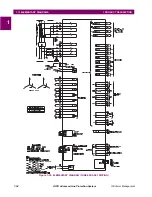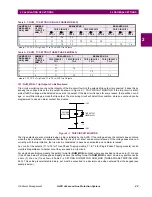
1-44
ALPS Advanced Line Protection System
GE Power Management
1.11 COMPENSATED POSITIVE SEQUENCE OVERVOLTAGE (OPTIONAL)
1 PRODUCT DESCRIPTION
1
1.11 COMPENSATED POSITIVE SEQUENCE OVERVOLTAGE (OPTIONAL)
1.11.1 DESCRIPTION
The positive-sequence overvoltage option includes four separately-adjustable overvoltage functions: an instantaneous unit
and a definite-time overvoltage unit that responds to
V
A1
, and an instantaneous unit and a definite-time overvoltage unit
that responds to
. The compensated voltage,
, is intended to reproduce the positive-sequence
voltage present on the line
Z
R
ohms from the relay location.
Figure 1–25: COMPENSATED POSITIVE-SEQUENCE OVERVOLTAGE
1.11.2 APPLICATION
The compensated positive-sequence overvoltage function is intended to provide tripping of transmission lines when the line
voltage is high enough to endanger system operation. The series-compensated overvoltage function provides instanta-
neous and time-delayed tripping on either the local positive-sequence voltage (
V
A
1
) or on the compensated positive-
sequence voltage (
V
A
1
– I
A
1
Z
R
). The positive-sequence voltage is intended to measure the voltage at the relay location,
while the compensated positive-sequence voltage is intended to approximate the voltage at the far end of the line when
Z
R
is set to reflect the rise in the line due to capacitance charging.
These functions provide the following advantages:
•
A local measurement of the balanced voltage.
•
A remote measurement of the voltage at the far end of the line, which can detect:
1.
High voltage due to an open line and trip the energized end. This is important, since with high voltage, more
corona may exist on the line and inhibit the proper reception of a carrier-transfer-trip signal.
2.
The open line, creating the bus high voltage and providing selective tripping of the proper line.
This function must be set high enough to allow safe normal operation while tripping for high voltages. Because of transients
involved in line energization, the instantaneous function should be set at least 15% higher than the voltage obtained or cal-
culated for a steady-state line energization.
If the relay reach,
Z
R
, is set to half the line impedance, the compensated voltage (
V
A1
- I
A1
Z
R
) will be approximately equal
to the positive-sequence voltage at the remote end of the line (due to the Ferranti effect when the remote terminal is open).
A more accurate setting of
Z
R
may be made if the positive-sequence charging current (
I
C
) and the voltages at the near and
remote line ends (
V
N
and
V
R
) resulting from an open breaker are known. In this case, the desired reach setting would be:
V
A1
I
A1
Z
R
–
V
A1
I
A1
Z
R
–
E
E
A
B
Z
R
I
C 1
PHASOR DIAGRAM
VA1 – I Z
C 1
R
V A 1
I
C 1
C 1
I
Z
R
B r e a k e r B i s o p e n
VA1: POSITIVE SEQUENCE VOLTAGE AT RELAY
IC1: POSITIVE SEQUENCE CHARGING CURRENT
ZR: FUNCTION REACH SETTING (=LINE IMPEDANCE)
Z
R
V
R
V
N
–
(
)
I
C
--------------------------
=










































